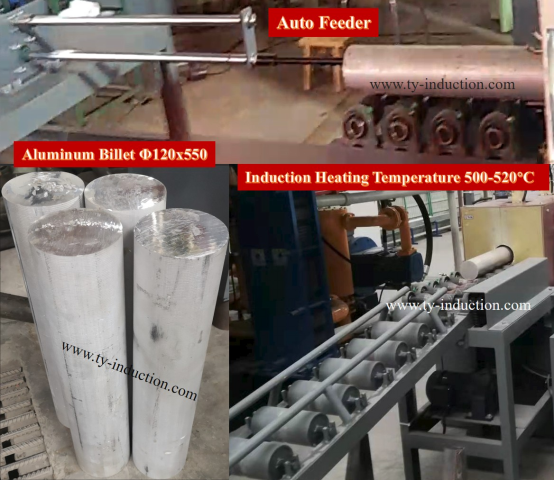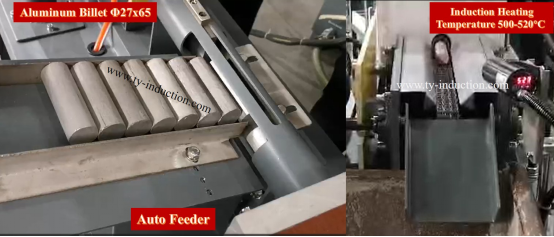Lightweight Materials Are Changing What Forging Shops Need from Equipment
August 07, 2025
The forging industry is experiencing a significant period of technological advancement. Driven by electric vehicles (EVs), aerospace innovations, and industrial efficiency requirements, global demand for lightweight, high-performance components is surging, and traditional forging processes are being re-evaluated.
Once optimized for heavy carbon steel components, forges now process aluminum, titanium, and advanced high-strength alloys, materials that behave very differently under thermal and mechanical stresses. These materials require greater precision, faster response, and smarter equipment—redefining the modern forging infrastructure.
To remain competitive, manufacturers must upgrade not just their materials strategy, but also their heating systems, automation, and control technologies.

TY INDUCTION provides a complete portfolio of advanced equipment designed specifically for the lightweight forging revolution:
· Non-Ferrous Metal Induction Heating System
· Induction Heating Systems for Forging
Engineered for precision, adaptability, and sustainability, our solutions empower forging shops to transition seamlessly into the lightweight future—delivering higher quality, lower costs, and faster time-to-market.
We don’t just supply equipment—we partner with forging manufacturers to redefine what’s possible. From process consulting to turnkey automation, TY INDUCTION helps you future-proof your operations.
Contact us today to upgrade your forging line for the age of lightweight materials.

Lightweight metals are no longer niche—they are central to next-generation product design across key industries:
Industry | Applications | Material Used |
Electric Vehicles | Battery enclosures, chassis, motor shafts, transmission gears | Aluminum alloys, high-strength steels |
Aerospace | Airframes, landing gear, engine components | Titanium, aluminum-lithium alloys |
Industrial Equipment | Lightweight gears, shafts, actuators | High-strength aluminum, maraging steels |
Key Drivers Behind the Shift
· Electrification & Range Optimization: Every kilogram saved in an EV increases battery range and reduces energy consumption.
· Performance Demands: Lightweight alloys offer superior strength-to-weight ratios, enabling higher efficiency and dynamic response.
· Environmental Regulations: Stricter emissions standards push OEMs toward lightweighting as a core sustainability strategy.
· Fuel Efficiency (Aerospace): Aircraft manufacturers seek up to 20% weight reduction to cut fuel use and CO₂ output.
However, forging these materials introduces new technical hurdles that legacy equipment cannot reliably overcome.
Unlike traditional carbon steels, lightweight alloys exhibit unique behaviors that complicate forging:
Challenge | Material Affected | Impact |
Thermal Sensitivity | Aluminum, titanium | Narrow forging windows; overheating causes grain growth or melting |
Rapid Heat Dissipation | Aluminum | Requires faster heating and shorter transfer times |
Oxidation & Scaling | Titanium | Surface degradation if heated in air without protection |
Cracking & Tearing | Both aluminum and titanium | Due to low ductility at suboptimal temperatures |
Non-Uniform Microstructure | All lightweight alloys | Inconsistent heating leads to weak spots and reduced fatigue life |
These challenges demand equipment that delivers precise, localized, and rapid thermal control—alongside mechanical systems capable of adaptive force application.
Modern forging shops must transition from rigid, high-mass systems to flexible, intelligent, and energy-efficient platforms. The new requirements span four key areas:
Traditional gas furnaces or resistance heaters are too slow and imprecise for lightweight alloys.
Induction heating has emerged as the preferred solution due to:
· Rapid heating rates (seconds vs. minutes)
· Zone-specific control (partial heating of billets)
· ±5°C temperature accuracy via closed-loop feedback
· Reduced oxidation (shorter exposure time)
Modern induction heating systems for forging enable precise thermal profiles tailored to each alloy—critical for aluminum (500–540°C) and titanium (900–1000°C).
Manual handling introduces variability, especially with sensitive materials. Today’s forging lines require:
· Robotic material handling to minimize heat loss during transfer
· Programmable logic controllers (PLCs) for repeatable process sequences
· Auto induction forging machines that adjust parameters based on material ID or size
For example, automated induction forging machines for transmission gears can switch between aluminum and steel gears with minimal downtime—enabling mixed-model production on a single line.
Forging shops serving multiple industries need multi-material readiness. This requires:
· Quick-change tooling and dies
· Material-specific heating profiles stored in machine memory
· Force modulation to avoid over-stressing lightweight billets
Advanced systems use barcode or RFID scanning to auto-select forging recipes, reducing setup time and human error.
With rising energy costs and ESG commitments, efficiency is non-negotiable.
Induction heating offers up to 65% energy savings compared to gas furnaces by:
· Applying energy only where and when needed
· Eliminating standby losses
· Reducing cycle times and scrap rates
This makes induction not just a technical upgrade—but a strategic sustainability investment.
To meet evolving demands, forging shops are investing in the following induction-based solutions:
Equipment | Function | Benefits |
Induction Heating System for Forging | Rapid, uniform preheating of billets and bars | Enables precise thermal control for sensitive alloys |
Advanced Auto Induction Forging Machines (e.g., for Transmission Gears) | Fully automated forging with integrated heating | Consistent quality, high throughput, low labor |
Billet/Bar Induction Total Heating Equipment | Heats entire workpiece uniformly | Ideal for symmetrical parts requiring full homogenization |
Billet/Bar Induction Partial Heating Machine | Selectively heats specific zones (e.g., gear teeth, flanges) | Saves energy, preserves properties in non-forged areas |
These systems form the backbone of a modern, agile forging cell capable of handling multi-material, low-volume/high-mix, or high-volume standardized production.
Benefit | Impact |
Higher Throughput | Faster heating and automation reduce cycle times by up to 30–40% |
Improved Quality | Uniform microstructure, reduced cracking, tighter tolerances |
Energy Efficiency | Targeted heating lowers power consumption and carbon footprint |
Reduced Labor | Automation allows fewer operators to manage more machines |
Greater Flexibility | One line handles aluminum, titanium, and steel with quick changeover |
Process Traceability | Data logging enables full quality traceability per IATF 16949, AS9100 |
A Tier-1 forging shop producing transmission gears for electric drivetrains upgraded from gas heating to a fully integrated auto induction forging line.
· Induction total heating for initial billet preheating
· Partial induction heating for gear tooth preforming
· Robotic transfer to forging press
· Closed-loop temperature monitoring with IR sensors
· Cycle time reduced by 32%
· Scrap rate dropped from 8% to 3.5%
· Energy consumption per part down by 37%
· Changeover time between aluminum and steel gears reduced from 90 min to <15 min
Outcome: The shop now runs 24/7 with two operators per shift, achieving scalable, defect-free production of lightweight transmission components.
Trend | What It Means for Forging Shops |
More Titanium in EVs & Aerospace | Need for controlled-atmosphere induction heating to prevent oxidation |
Smart Forging Cells | Integration of sensors, AI, and real-time analytics for self-optimizing processes |
Hybrid Heating Systems | Combine total and partial induction for multi-zone thermal management |
Digital Twins & Simulation | Virtual process modeling to optimize forging parameters before production |
Industry 4.0 Integration | Remote monitoring, predictive maintenance, cloud-based quality tracking |
The rise of lightweight materials is not just changing what is forged—but how and with what equipment.
Forging shops that continue to rely on outdated, steel-centric systems risk falling behind in quality, efficiency, and competitiveness. To thrive in the era of EVs, aerospace innovation, and sustainable manufacturing, they must adopt next-generation induction forging solutions.
Investing in:
· Precision induction heating systems
· Automated forging machines
· Flexible, energy-efficient production lines
Hot Products
Contact Us
Enquiry hotline:
+86 135 4128 7190
Email:
Address:
No.18,14th Floor, Building 2, No. 169 Zhongli Road, Banzhuyuan Subdistrict, Xindu District, Chengdu, Sichuan, China, Code:610000
